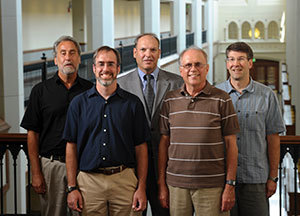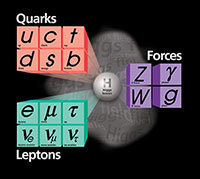
On Thursday (March 14), at the Rencontres de Moriond conference in La Thuile, Italy, the ATLAS and CMS (compact muon solenoid) collaborations at CERN’s Large Hadron Collider (LHC) presented preliminary new results that further elucidate the particle discovered last summer.
“In July of last year, we presented compelling evidence for the discovery of the Higgs boson, observing its decays to vector bosons, but had insufficient data to confirm that it behaved exactly as we thought it should and to measure all of its possible decays,” says Colin Jessop, professor of physics and team leader of the Notre Dame group that is part of the CMS collaboration. “Now we have two and a half times more data, which has allowed us to confirm the existence of predicted decays to fermions, and to measure the spin and parity of the Higgs. We can now say with some surety that the new particle behaves exactly as a Higgs boson should.”

All of the particles that comprise the visible matter of the entire universe can be broadly classified into two types: fermions and bosons. Fermions include the quarks that make up the atomic nucleus and the electrons that orbit it, while bosons are the messenger particles that communicate the forces in the universe at the subatomic level, such as the photon, which is the quanta of visible light. All of them are given mass via their interaction with the Higgs boson, which is thereby responsible for the mass of the universe. It is thus of central importance to confirm that the Higgs boson interacts with fermions as it should.
The Notre Dame team includes physics faculty members Jessop, Mike Hildreth, Kevin Lannon, Nancy Marinelli, Randy Ruchti, Mitch Wayne and a number of postdoctoral researchers, engineers, graduate students and undergraduate students. “We work within a broader collaboration of scientists, but our focus within the collaboration on Higgs physics and the detectors and software needed to observe the Higgs has been very successful and has allowed us to make many significant contributions and to be at the heart of the Higgs data analysis,” says Jessop. “For example, three of our graduate students, Doug Berry, Nil Valls and Wuming Luo, will defend their Ph.D. thesis on the recent Higgs results in the next few months, and undergraduate Kevin McDermott is working with us on the next round of results due this summer.”
The team is planning to continue its detailed study of the Higgs for the next several years, further confirming its properties and searching for new exotic decays that may be a sign of new unexpected interactions. The experiment will continue to collect and analyze data until 2020 in its first phase. The Notre Dame team is now working on an upgraded detector to run from 2023 to 2035. “The discovery of the Higgs boson has opened up an enormous number of possible avenues of research both at CMS and elsewhere, and we view this as the beginning of a new era in which Notre Dame will continue to play a central role,” says Jessop.
Contact: Colin Jessop, 574-631-5657, cjessop@nd.edu
Originally published by at news.nd.edu on March 14, 2013.